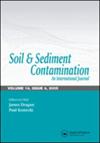通过使用氮肥促进和抑制土壤石油生物降解:确定最佳水平的方法
IF 1.5
4区 环境科学与生态学
Q4 ENVIRONMENTAL SCIENCES
引用次数: 79
摘要
通过室内研究,评价了石油污染土壤中土壤含水量与微生物对土壤氮响应之间的关系。在砂质、砂质壤土和粉质壤土中添加不同水平的氮。对每种土壤(石油损失或二氧化碳产生)的生物降解程度的测量表明,生物降解与以土壤水分(mg N/kg土壤H2O或mg N/I)为函数的土壤氮的关系优于以土壤干物质(mg N/kg土壤)为函数的土壤氮的关系。采用4个N水平(0、250、500、750 mg N/kg土壤)对壤土砂进行处理,并在3种含水量(按干土质量计算为5.0、7.5和10.0%)下进行培养。土壤水势和耗氧量与以土壤水分为基础的氮表达关系最为密切。结果表明,以mg N/kg土壤水为单位(可通过[mg N/kg干土]除以[土壤含水量]获得)的N可用于确定生物修复过程的施肥量。在此基础上……本文章由计算机程序翻译,如有差异,请以英文原文为准。
Enhancement and inhibition of soil petroleum biodegradation through the use of fertilizer nitrogen: An approach to determining optimum levels
Laboratory studies were conducted to evaluate the relationship between soil water content and microbial response to soil nitrogen (N) in petroleum‐contaminated soils. Various levels of N were added to a sand, a sandy loam, and a silt loam. Measurements of the extent of biodegradation in each soil (petroleum loss or CO2 production) indicated that biodegradation was related to soil N expressed as a function of soil water (mg N/kg soil H2O or mg N/I) better than N expressed as a function of soil dry matter (mg N/kg soil). A loamy sand was treated with four levels of N (0, 250, 500, 750 mg N/kg soil) and incubated at three water contents (5.0, 7.5, and 10.0% on a dry soil weight basis). Soil water potential and O2 consumption were best related to N expressed on the basis of soil water. It is concluded that expressing N in units of mg N/kg soil H2O (easily obtained by dividing [mg N/kg dry soil] by [soil moisture content]) can be used to determine fertilization rates for bioremediation processes. On this basis...
求助全文
通过发布文献求助,成功后即可免费获取论文全文。
去求助
来源期刊

Soil & Sediment Contamination
环境科学-环境科学
CiteScore
4.20
自引率
10.00%
发文量
53
审稿时长
2.2 months
期刊介绍:
When it comes to assessing and mitigating contaminated soils and sediments, there is no substitute for having the very latest tools, techniques and methodologies at your fingertips to help you deal with these issues efficiently and cost-effectively.
This is just the kind of essential expertise you’ll only find in Soil and Sediment Contamination . This internationally, peer-reviewed publication focuses on soil and sediment contamination from:
-Sludges-
Petroleum-
Petrochemicals-
Chlorinated hydrocarbons-
Pesticides-
Lead and other heavy metals.
Get detailed descriptions of all the latest and most efficient offsite and in situ remediation techniques, strategies for assessing health effects and hazards, and tips for dealing with everyday regulatory and legal issues. With the state-of-the-art tools that Soil and Sediment Contamination provides, you can successfully assess, mitigate, and solve both rural and urban soil contamination problems as efficiently and economically as possible.
 求助内容:
求助内容: 应助结果提醒方式:
应助结果提醒方式:


